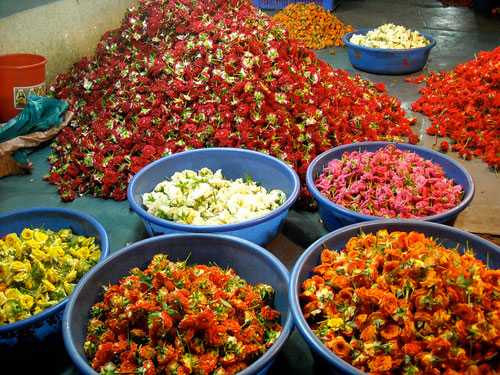
Customs and Cuisine of India
Food of India is characterized by strong aroma and bold tastes where spices are of the utmost importance. The spices determine the flavor, appearance and taste of every meal. However, in India measurements are not used while cooking. A cook relies on his or her senses while sprinkling the spices on preparations because it is believed that it is the love of the cook that brings taste to the food rather than the spices themselves.
Maharashtrian cuisine is the cuisine of the Marathi people from the state of Maharashtra in Western India. The cuisine can range from mild to very spicy dishes. Wheat, rice, vegetables, lentils and fruit form staples of the Maharashtrian diet. Peanuts and cashews are often served with vegetables. Due to economic and cultural preferences meat has traditionally been used quite sparsely, or only by the well off until recently. The metropolitan cities of Mumbai and Pune have influenced the food culture, bringing more sophisticated dishes and ingredients into the mix, along with Chinese dishes as well. Nevertheless, distinctly Maharashtrian dishes, such as ukdiche modak (rice flour dumpling with sweet jiggery, coconut, and nut filling) and aluchi patal bhaji (Colocasia leaf curry) served at festive occasions remain popular. For more recipes and information on dishes specific to Maharashtra see the link below.
http://www.tarladalal.com/recipes-for-maharashtrian-52?pageindex=3
Dining Etiquette:
Dining etiquette in India is quite different to Western countries. There it is considered proper Indian etiquette to eat with your hands; this is how the majority of the Indian people eat. It is tradition and part of the Indian culture; it is also an accepted part of Indian etiquette.
Indian etiquette and good manners vary from region to region. For instance, in North India it is impolite to dirty more than the first two segments of your fingers. Since North Indians eat mostly rotis and drier curries, this isn’t too difficult. Whereas in the South, where they eat lots more rice, and enjoy very wet curries, it is permitted to use your whole hand, so if you are not sure what to do, just observe or ask.
Part of the traditional Indian etiquette and culture is to share food. Especially on long train journeys, Indian families will be carrying heaps of food and will invite you to have some. Even when only two people are dining in a restaurant it is customary to order two different dishes and in keeping with Indian etiquette, share the dishes between you.
While sharing is an important part of Indian etiquette, it is poor and offensive etiquette to share a fork or spoon or to drink from someone’s glass. This also applies to taking a bite of someone else’s sandwich, ice cream or chocolate too. Also, never, ever ‘double dip’!
It is not difficult to eat with your fingers, but there are a few rules of Indian etiquette that have to be observed:
- The left hand is not used for eating (even if you are left-handed), this is considered offensive and unclean.
- Wait to be served. Remember you are eating with your hands and your right hand will be messy, therefore you will leave the serving spoon all sticky and messy too.
- The hygiene of jootha: While sharing is good Indian etiquette and manners, sharing a glass, spoon, drinking bottle etc., coming into contact with another’s spit is called jootha and is considered offensive in many parts of India.
- In Indian etiquette never offer anyone food from your thali, even if it is in one of the little bowls and you haven’t touched it. All the food that is placed on your thali becomes jootha. There is no precise English equivalent of jootha. ‘Contaminated’ comes closest in meaning. Mostly Indian etiquette has the same basic rules as Western etiquette, for example: Wash your hands before and after a meal.
Sources:
Cuisine: Wikipedia
Customs: http://www.a-to-z-of-manners-and-etiquette.com/indian-etiquette.html
Reprinted in part from October 2012
View Recipes from India
India
